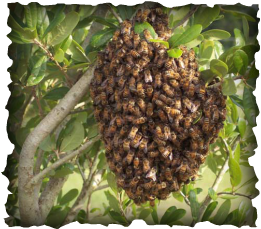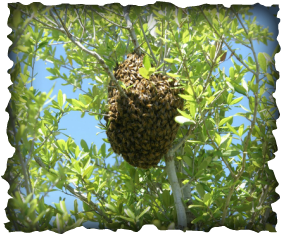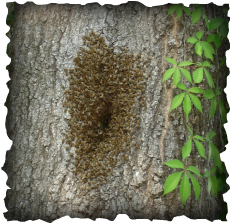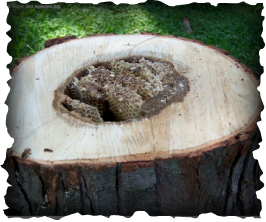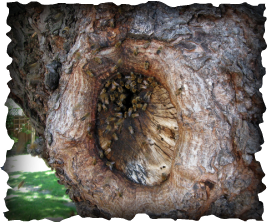Bee Swarms
Swarms:
Swarming is a natural part of the development of a honey bee colony. Swarming is a method of propagation that occurs in response to crowding within the colony. A new honey bee colony is formed when the queen bee leaves the colony with a large group of worker bees, a process called swarming. In the prime swarm, about 60% of the worker bees leave the original hive location with the old queen. This swarm can contain thousands to tens of thousands of bees.
What Causes Honey Bees to Swarm:
Swarming usually occurs in late spring and early summer and begins in the warmer hours of the day. Swarming bees fly around briefly and then cluster on a tree limb, shrub or other object. Clusters usually remain stationary for an hour to a few days, depending on weather and the time needed to find a new nest site by scouting bees. When a suitable location for the new colony, such as a hollow tree, is found the cluster breaks up and flies to it. Honey bee swarms are not highly dangerous under most circumstances. Swarming honey bees feed prior to swarming, reducing their ability to sting.
What You Should Do:
Encountering a bee swarm for the first time can be alarming. Bees tend to swarm near their hives or honeycombs, so if a swarm is visible then a nest is nearby. In most situations when a honey bee swarm is found on a tree, shrub or house you do not need to do anything. Swarms are temporary and the bees will move on if you patiently ignore them. Stay back and keep others away from the swarm, but feel free to admire and appreciate the bees from a safe distance. Swarms are usually not aggressive unless provoked, so it is important to keep a good distance from the swarm. If the bees feel threatened, they will use their stingers and release a pheromone to alert the other bees of the threat resulting in a large bee attack. We will capture the bees in a caged container so they can be transported to a bee observation hive. While capturing the bees, smoke is used to calm the bees which makes it safer and easier to remove the colony. If a serious health threat is present because of the location of the swarm, such as in a highly traveled public area, you should call HowToRemoveBees.com as soon as possible. We are available for emergencies 24x7.
Swarming is a natural part of the development of a honey bee colony. Swarming is a method of propagation that occurs in response to crowding within the colony. A new honey bee colony is formed when the queen bee leaves the colony with a large group of worker bees, a process called swarming. In the prime swarm, about 60% of the worker bees leave the original hive location with the old queen. This swarm can contain thousands to tens of thousands of bees.
What Causes Honey Bees to Swarm:
Swarming usually occurs in late spring and early summer and begins in the warmer hours of the day. Swarming bees fly around briefly and then cluster on a tree limb, shrub or other object. Clusters usually remain stationary for an hour to a few days, depending on weather and the time needed to find a new nest site by scouting bees. When a suitable location for the new colony, such as a hollow tree, is found the cluster breaks up and flies to it. Honey bee swarms are not highly dangerous under most circumstances. Swarming honey bees feed prior to swarming, reducing their ability to sting.
What You Should Do:
Encountering a bee swarm for the first time can be alarming. Bees tend to swarm near their hives or honeycombs, so if a swarm is visible then a nest is nearby. In most situations when a honey bee swarm is found on a tree, shrub or house you do not need to do anything. Swarms are temporary and the bees will move on if you patiently ignore them. Stay back and keep others away from the swarm, but feel free to admire and appreciate the bees from a safe distance. Swarms are usually not aggressive unless provoked, so it is important to keep a good distance from the swarm. If the bees feel threatened, they will use their stingers and release a pheromone to alert the other bees of the threat resulting in a large bee attack. We will capture the bees in a caged container so they can be transported to a bee observation hive. While capturing the bees, smoke is used to calm the bees which makes it safer and easier to remove the colony. If a serious health threat is present because of the location of the swarm, such as in a highly traveled public area, you should call HowToRemoveBees.com as soon as possible. We are available for emergencies 24x7.
Bee Trees
A Bee Tree is a tree in which a colony of honey bees makes its home. A colony of bees may live in a bee tree for many years. Most bee trees have a large inner hollow, often with an upper and lower entrance. A bee colony needs to be protected from weather and other environmental nuisances and because of this, a tree gives the colony that protection. If you have a tree that bees have moved into, there is no easy way to remove them besides cutting into tree or cutting it down. Colonies in trees have fixed combs, so inspection and management is impossible, as is most harvesting without destroying the colony. We can perform a cut-out on a hive. The trunk is cut open to expose the cavity, and the comb is carefully removed. That being said, cutting the tree to retrieve the bees & moving them to a bee farm takes quite a bit of time & labor. This procedure can cost extensive amount of money for the customer and only a small percentage of the bees surviving the transport in most cases. Do not have the bees exterminated & leave the tree standing. The honey & comb will still be in the tree which can attract wax moths, mice & other pests which can lead to other pest problems and more money spent to exterminate again.
